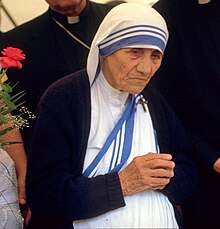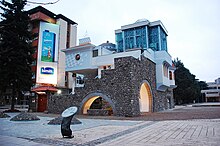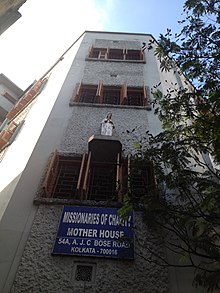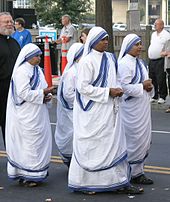Mother Teresa
For other uses, see Maria Theresa (disambiguation).
| Blessed Teresa of Calcutta, M.C. | |
|---|---|

Mother Teresa at a pro-life meeting in 1986 in Bonn, West Germany
|
|
| Religion | Roman Catholic |
| Institute | Sisters of Loreto (1928–1948) Missionaries of Charity (1950–1997) |
| Personal | |
| Nationality | Ottoman subject (1910–1912) Serbian subject (1912–1915) Bulgarian subject (1915–1918) Yugoslavian subject (1918–1943) Yugoslavian citizen (1943–1948) Indian subject (1948–1950) Indian citizen[1][2] (1948–1997) |
| Born | Anjezë Gonxhe Bojaxhiu 26 August 1910 Üsküp, Kosovo Vilayet, Ottoman Empire (modern Skopje, Macedonia) |
| Died | 5 September 1997 (aged 87) Calcutta, West Bengal, India |
| Senior posting | |
| Title | Superior General |
| Period in office | 1950–1997 |
| Successor | Sister Nirmala Joshi, M.C. |
| Blessed Teresa of Calcutta M.C. |
|
|---|---|

Bl. Mother Teresa Statue in St. Thomas Mount.
|
|
| Nun | |
| Born | 26 August 1910 Üsküp, Kosovo Vilayet, Ottoman Empire |
| Died | 5 September 1997 (aged 87) Calcutta, West Bengal, India |
| Venerated in | Roman Catholic Church (India) |
| Beatified | 19 October 2003, Saint Peter's Square, Vatican City by Pope John Paul II |
| Major shrine | Mother House of the Missionaries of Charity, Calcutta, West Bengal, India |
| Feast | 5 September |
| Attributes |
|
| Patronage | |
Mother Teresa founded the Missionaries of Charity, a Roman Catholic religious congregation, which in 2012 consisted of over 4,500 sisters and is active in 133 countries. They run hospices and homes for people with HIV/AIDS, leprosy and tuberculosis; soup kitchens; dispensaries and mobile clinics; children's and family counselling programmes; orphanages; and schools. Members must adhere to the vows of chastity, poverty and obedience as well as a fourth vow, to give "wholehearted free service to the poorest of the poor".[10]
Mother Teresa was the recipient of numerous honours including the 1979 Nobel Peace Prize. In 2003, she was beatified as "Blessed Teresa of Calcutta". A second miracle credited to her intercession is required before she can be recognised as a saint by the Catholic Church.[3]
A controversial figure both during her life and after her death, Mother Teresa was widely admired by many for her charitable works, but also widely criticised, particularly for her efforts opposing contraception and for substandard conditions in the hospices for which she was responsible.[11][12][13][14]
Contents
Early life

Memorial House of Mother Teresa, in her native Skopje.
| Part of a series on |
| Christianity in India |
|---|
 |
| Indian Christianity portal |
She was the youngest of the children of Nikollë and Dranafile Bojaxhiu (Bernai).[18] Her father, who was involved in Albanian politics, died in 1919 when she was eight years old.[15][19] Her father may have been from Prizren, Kosovo while her mother may have been from a village near Gjakova.[20]
According to a biography written by Joan Graff Clucas, in her early years Agnes was fascinated by stories of the lives of missionaries and their service in Bengal, and by age 12 had become convinced that she should commit herself to a religious life.[21] Her final resolution was taken on 15 August 1928, while praying at the shrine of the Black Madonna of Letnice, where she often went on pilgrimage.[22]
She left home at age 18 to join the Sisters of Loreto as a missionary. She never again saw her mother or sister.[23]
Agnes initially went to the Loreto Abbey in Rathfarnham, Ireland, to learn English, the language the Sisters of Loreto used to teach school children in India.[24] She arrived in India in 1929, and began her novitiate in Darjeeling, near the Himalayan mountains,[25] where she learnt Bengali and taught at the St. Teresa's School, a schoolhouse close to her convent.[26] She took her first religious vows as a nun on 24 May 1931. At that time she chose to be named after Thérèse de Lisieux, the patron saint of missionaries,[27][28] but because one nun in the convent had already chosen that name, Agnes opted for the Spanish spelling Teresa.[29]
She took her solemn vows on 14 May 1937, while serving as a teacher at the Loreto convent school in Entally, eastern Calcutta.[15][30][31] Teresa served there for almost twenty years and in 1944 was appointed headmistress.[32]
Although Teresa enjoyed teaching at the school, she was increasingly disturbed by the poverty surrounding her in Calcutta (Kolkata).[33] The Bengal famine of 1943 brought misery and death to the city; and the outbreak of Hindu/Muslim violence in August 1946 plunged the city into despair and horror.[34]
Missionaries of Charity
Main article: Missionaries of Charity

Missionaries of Charity's Mother House (Headquarters) in Kolkata

Missionaries of charity with the traditional sari.
She began her missionary work with the poor in 1948, replacing her traditional Loreto habit with a simple white cotton sari decorated with a blue border. Mother Teresa adopted Indian citizenship, spent a few months in Patna to receive a basic medical training in the Holy Family Hospital and then ventured out into the slums.[37][38] Initially, she started a school in Motijhil (Calcutta); soon she started tending to the needs of the destitute and starving.[39] In the beginning of 1949, she was joined in her effort by a group of young women and laid the foundations to create a new religious community helping the "poorest among the poor".
Her efforts quickly caught the attention of Indian officials, including the prime minister, who expressed his appreciation.[40]
Teresa wrote in her diary that her first year was fraught with difficulties. She had no income and had to resort to begging for food and supplies. Teresa experienced doubt, loneliness and the temptation to return to the comfort of convent life during these early months. She wrote in her diary:
Our Lord wants me to be a free nun covered with the poverty of the cross. Today, I learned a good lesson. The poverty of the poor must be so hard for them. While looking for a home I walked and walked till my arms and legs ached. I thought how much they must ache in body and soul, looking for a home, food and health. Then, the comfort of Loreto [her former congregation] came to tempt me. 'You have only to say the word and all that will be yours again,' the Tempter kept on saying ... Of free choice, my God, and out of love for you, I desire to remain and do whatever be your Holy will in my regard. I did not let a single tear come.[41]Teresa received Vatican permission on 7 October 1950 to start the diocesan congregation that would become the Missionaries of Charity.[42] Its mission was to care for, in her own words, "the hungry, the naked, the homeless, the crippled, the blind, the lepers, all those people who feel unwanted, unloved, uncared for throughout society, people that have become a burden to the society and are shunned by everyone."
It began as a small congregation with 13 members in Calcutta; by 1997 it had grown to more than 4,000 sisters running orphanages, AIDS hospices and charity centres worldwide, and caring for refugees, the blind, disabled, aged, alcoholics, the poor and homeless, and victims of floods, epidemics, and famine.[43]

2007 image of Mother Teresa's Home for the Dying, Nirmal Hriday, in Kolkata.
Mother Teresa soon opened a home for those suffering from Hansen's disease, commonly known as leprosy, and called the hospice Shanti Nagar (City of Peace).[46] The Missionaries of Charity also established several leprosy outreach clinics throughout Calcutta, providing medication, bandages and food.[47]
As the Missionaries of Charity took in increasing numbers of lost children, Mother Teresa felt the need to create a home for them. In 1955 she opened the Nirmala Shishu Bhavan, the Children's Home of the Immaculate Heart, as a haven for orphans and homeless youth.[48]
The congregation soon began to attract both recruits and charitable donations, and by the 1960s had opened hospices, orphanages and leper houses all over India. Mother Teresa then expanded the congregation throughout the globe. Its first house outside India opened in Venezuela in 1965 with five sisters.[49] Others followed in Rome, Tanzania, and Austria in 1968; during the 1970s the congregation opened houses and foundations in dozens of countries in Asia, Africa, Europe and the United States.[50]
The Missionaries of Charity Brothers was founded in 1963, and a contemplative branch of the Sisters followed in 1976. Lay Catholics and non-Catholics were enrolled in the Co-Workers of Mother Teresa, the Sick and Suffering Co-Workers, and the Lay Missionaries of Charity. In answer to the requests of many priests, in 1981 Mother Teresa also began the Corpus Christi Movement for Priests,[51] and in 1984 founded with Fr. Joseph Langford the Missionaries of Charity Fathers[52] to combine the vocational aims of the Missionaries of Charity with the resources of the ministerial priesthood. By 2007 the Missionaries of Charity numbered approximately 450 brothers and 5,000 sisters worldwide, operating 600 missions, schools and shelters in 120 countries.[53]
International charity
Mother Teresa said "By blood, I am Albanian. By citizenship, an Indian. By faith, I am a Catholic nun. As to my calling, I belong to the world. As to my heart, I belong entirely to the Heart of Jesus."[2]In 1982, at the height of the Siege of Beirut, Mother Teresa rescued 37 children trapped in a front line hospital by brokering a temporary cease-fire between the Israeli army and Palestinian guerrillas.[54] Accompanied by Red Cross workers, she travelled through the war zone to the devastated hospital to evacuate the young patients.[55]
When Eastern Europe experienced increased openness in the late 1980s, she expanded her efforts to Communist countries that had previously rejected the Missionaries of Charity, embarking on dozens of projects. She was undeterred by criticism about her firm stand against abortion and divorce stating, "No matter who says what, you should accept it with a smile and do your own work." She visited the Soviet republic of Armenia following the 1988 earthquake,[56] and met with Nikolai Ryzhkov, the Chairman of the Council of Ministers.[57]
Mother Teresa travelled to assist and minister to the hungry in Ethiopia, radiation victims at Chernobyl, and earthquake victims in Armenia.[58][59][60] In 1991, Mother Teresa returned for the first time to her homeland and opened a Missionaries of Charity Brothers home in Tirana, Albania.
By 1996, Mother Teresa was operating 517 missions in more than 100 countries.[61] Over the years, Mother Teresa's Missionaries of Charity grew from twelve to thousands serving the "poorest of the poor" in 450 centres around the world. The first Missionaries of Charity home in the United States was established in the South Bronx, New York; by 1984 the congregation operated 19 establishments throughout the country.[62] Mother Teresa was fluent in five languages: Bengali,[63] Albanian, Serbian, English, and Hindi.[64]
Declining health and death
Mother Teresa suffered a heart attack in Rome in 1983 while visiting Pope John Paul II. After a second attack in 1989, she received an artificial pacemaker. In 1991, after a battle with pneumonia while in Mexico, she suffered further heart problems. She offered to resign her position as head of the Missionaries of Charity, but the sisters of the congregation, in a secret ballot, voted for her to stay. Mother Teresa agreed to continue her work as head of the congregation.[65]In April 1996, Mother Teresa fell and broke her collar bone. In August she suffered from malaria and failure of the left heart ventricle. She had heart surgery but it was clear that her health was declining. The Archbishop of Calcutta, Henry Sebastian D'Souza, said he ordered a priest to perform an exorcism on Mother Teresa with her permission when she was first hospitalised with cardiac problems because he thought she may be under attack by the devil.[66]
On 13 March 1997, she stepped down from the head of Missionaries of Charity. She died on 5 September 1997.[67]
At the time of her death, Mother Teresa's Missionaries of Charity had over 4,000 sisters, and an associated brotherhood of 300 members, operating 610 missions in 123 countries.[68] These included hospices and homes for people with HIV/AIDS, leprosy and tuberculosis, soup kitchens, children's and family counselling programs, personal helpers, orphanages, and schools. The Missionaries of Charity were also aided by Co-Workers, who numbered over 1 million by the 1990s.[69]
Mother Teresa lay in repose in St Thomas, Kolkata for one week prior to her funeral, in September 1997. She was granted a state funeral by the Indian government in gratitude for her services to the poor of all religions in India.[70] Her death was mourned in both secular and religious communities. In tribute, Nawaz Sharif, the Prime Minister of Pakistan said that she was "a rare and unique individual who lived long for higher purposes. Her life-long devotion to the care of the poor, the sick, and the disadvantaged was one of the highest examples of service to our humanity."[71] The former U.N. Secretary-General Javier Pérez de Cuéllar said: "She is the United Nations. She is peace in the world."[71]
Recognition and reception
In India
Mother Teresa had first been recognised by the Indian government more than a third of a century earlier when she was awarded the Padma Shri in 1962 and the Jawaharlal Nehru Award for International Understanding in 1969.[72] She continued to receive major Indian awards in subsequent years, including India's highest civilian award, the Bharat Ratna, in 1980.[73] Her official biography was written by an Indian civil servant, Navin Chawla, and published in 1992.[74]On 28 August 2010, to commemorate the 100th anniversary of her birth, the government of India issued a special 5 Rupee coin, being the sum she first arrived in India with. President Pratibha Patil said of Mother Teresa, "Clad in a white sari with a blue border, she and the sisters of Missionaries of Charity became a symbol of hope to many – the aged, the destitute, the unemployed, the diseased, the terminally ill, and those abandoned by their families."[75]
Indian views on Mother Teresa were not uniformly favourable. Her critic Aroup Chatterjee, who was born and raised in Calcutta but lived in London, reports that "she was not a significant entity in Calcutta in her lifetime". Chatterjee blames Mother Teresa for promoting a negative image of Calcutta, exaggerating the work done by her Mission, and misusing the funds and privileges at her disposal.[76] Her presence and profile grated in parts of the Indian political world, as she often opposed the Hindu Right. The Bharatiya Janata Party clashed with her over the Christian Dalits, but praised her in death, sending a representative to her funeral. The Vishwa Hindu Parishad, on the other hand, opposed the government's decision to grant her a state funeral. Its secretary Giriraj Kishore said that "her first duty was to the Church and social service was incidental" and accused her of favouring Christians and conducting "secret baptisms" of the dying.[77][78] But, in its front page tribute, the Indian fortnightly Frontline dismissed these charges as "patently false" and said that they had "made no impact on the public perception of her work, especially in Calcutta". Although praising her "selfless caring", energy and bravery, the author of the tribute was critical of Mother Teresa's public campaigning against abortion and that she claimed to be non-political when doing so.[79]
No comments:
Post a Comment